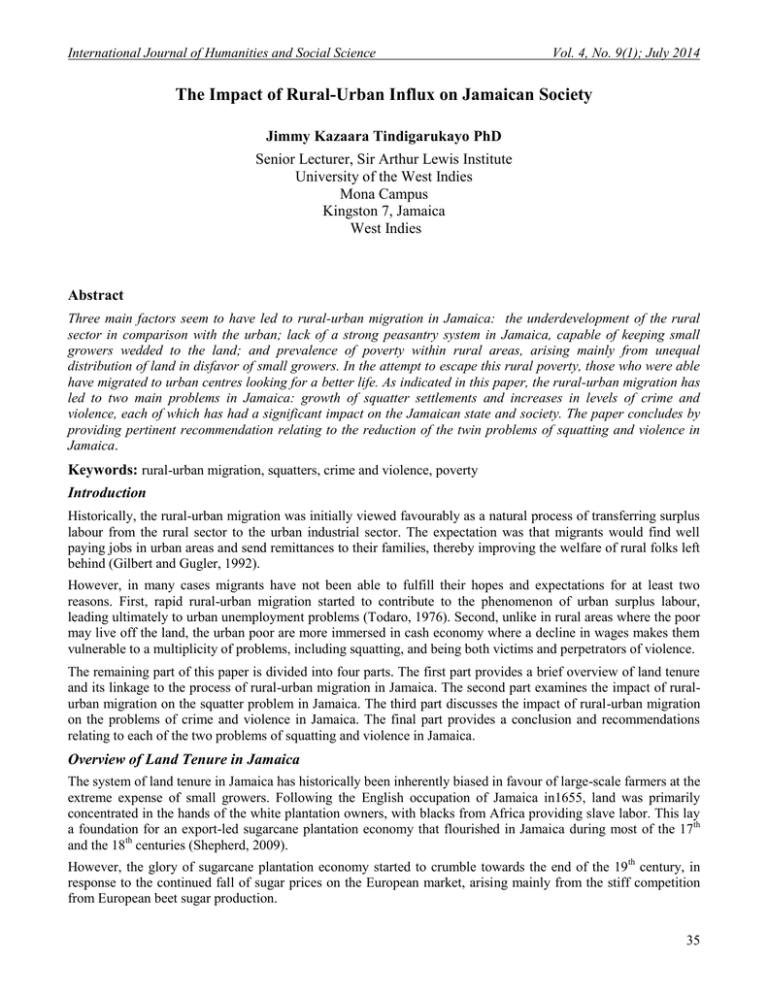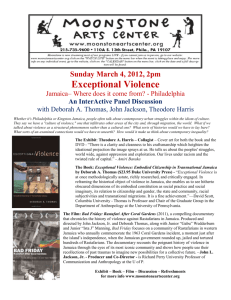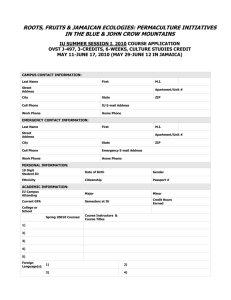Document 10465897
advertisement

International Journal of Humanities and Social Science Vol. 4, No. 9(1); July 2014 The Impact of Rural-Urban Influx on Jamaican Society Jimmy Kazaara Tindigarukayo PhD Senior Lecturer, Sir Arthur Lewis Institute University of the West Indies Mona Campus Kingston 7, Jamaica West Indies Abstract Three main factors seem to have led to rural-urban migration in Jamaica: the underdevelopment of the rural sector in comparison with the urban; lack of a strong peasantry system in Jamaica, capable of keeping small growers wedded to the land; and prevalence of poverty within rural areas, arising mainly from unequal distribution of land in disfavor of small growers. In the attempt to escape this rural poverty, those who were able have migrated to urban centres looking for a better life. As indicated in this paper, the rural-urban migration has led to two main problems in Jamaica: growth of squatter settlements and increases in levels of crime and violence, each of which has had a significant impact on the Jamaican state and society. The paper concludes by providing pertinent recommendation relating to the reduction of the twin problems of squatting and violence in Jamaica. Keywords: rural-urban migration, squatters, crime and violence, poverty Introduction Historically, the rural-urban migration was initially viewed favourably as a natural process of transferring surplus labour from the rural sector to the urban industrial sector. The expectation was that migrants would find well paying jobs in urban areas and send remittances to their families, thereby improving the welfare of rural folks left behind (Gilbert and Gugler, 1992). However, in many cases migrants have not been able to fulfill their hopes and expectations for at least two reasons. First, rapid rural-urban migration started to contribute to the phenomenon of urban surplus labour, leading ultimately to urban unemployment problems (Todaro, 1976). Second, unlike in rural areas where the poor may live off the land, the urban poor are more immersed in cash economy where a decline in wages makes them vulnerable to a multiplicity of problems, including squatting, and being both victims and perpetrators of violence. The remaining part of this paper is divided into four parts. The first part provides a brief overview of land tenure and its linkage to the process of rural-urban migration in Jamaica. The second part examines the impact of ruralurban migration on the squatter problem in Jamaica. The third part discusses the impact of rural-urban migration on the problems of crime and violence in Jamaica. The final part provides a conclusion and recommendations relating to each of the two problems of squatting and violence in Jamaica. Overview of Land Tenure in Jamaica The system of land tenure in Jamaica has historically been inherently biased in favour of large-scale farmers at the extreme expense of small growers. Following the English occupation of Jamaica in1655, land was primarily concentrated in the hands of the white plantation owners, with blacks from Africa providing slave labor. This lay a foundation for an export-led sugarcane plantation economy that flourished in Jamaica during most of the 17th and the 18th centuries (Shepherd, 2009). However, the glory of sugarcane plantation economy started to crumble towards the end of the 19 th century, in response to the continued fall of sugar prices on the European market, arising mainly from the stiff competition from European beet sugar production. 35 © Center for Promoting Ideas, USA www.ijhssnet.com The decline of sugar production in Jamaica was accompanied by large scale abandonment of sugarcane estates by white planters which, in turn, affected the former slaves, who had attained their emancipation in 1834, in two main ways. First, those who had depended on wages from the sugarcane plantation for subsistence were deprived of that source of livelihood. Second, most of the planters who were abandoning their large plantations refused to sell land to small producers, who were mostly former slaves, “preferring to sell their plantations intact rather than subdividing, even when this would fetch them higher prices” (Satchell, 1990: 63-64). Thus, being unemployed and unable to obtain good cultivatable land for subsistence farming, a good number of former slaves either captured idle land and squatted on it or migrated to urban centres in search of employment. Relating to the latter, for example, the population of Kingston during only a ten year period between 1881 and 1891 increased by 25.7%, from 38566 to 48504 (Jamaica Population Census of 1881 and 1891). The continued influx of rural population to urban areas, mainly due population pressure on cultivable land, has to date resulted in urban unemployment, overcrowding and crime, as will be discussed below. Rural/Urban Migration and the Squatter Problem in Jamaica Rural-urban migration is one of the main factors attributed to the formation and expansion of squatter settlements and slums world-wide (UN-Habitat, 2008). Since the 1950s, many people have, globally, left rural areas for urban centres mainly in search of opportunities and sources of improvements for their families, like jobs and better schools for children (Judy Baker, 2008). Underlying an influx of people from rural to urban centres in Jamaica are at least three possible explanations. First, like many other developing countries, Jamaica has pursued a policy that has persistently favoured urban development at the extreme expense of rural areas, thereby making the latter unattractive especially to the youth (Walsh, 1995). Secondly, a small number of farmers control most of arable farmland, leaving small farmers with marginal hillside land which, because of unsuitable farming techniques, often loses soil through flooding during rainy seasons. The third major factor underlying rural/urban migration in Jamaica is rural poverty. The majority of the poor in Jamaica (i.e. 60 % of those who live below the national poverty line) are found in rural areas. The Policy Development Unit (PDU) of the Planning Institute of Jamaica has provided possible explanations for this sad situation: skewed land distribution; an under-productive small farm sector; low levels of education; and underdeveloped physical and social infrastructure (Government of Jamaica, 1995: 4). Closely related to these explanations is the fourth one provided by A Framework for Local Sustainable Development Planning in Jamaica, arguing that there has been general lack of integration among four different types of ‘community capital’ (economic, social, environmental and human capital) at local levels, leading to a failure to attain sustainable development, especially in the rural areas (Government of Jamaica, Government of Canada Programme, 2001: 20-21). Because of the above and other related reasons, there has been an acceleration of urbanisation in Jamaica, which has taken place within the last five decades. In 1960 the percentage of the Jamaican population living in urban areas was 34%; by 2001, it had jumped to 52%; by 2011, it was 54% (Population and Housing Census 2011, Jamaica, Table 1.4); and by 2050 it is estimated to reach 65% (United Nations, 2012). This rapid urbanization, unaccompanied by an equal growth in the provision of affordable housing, has aggravated the problem of residential squatting in Jamaica. In the absence of affordable accommodation, new arrivals in urban centres have mostly resorted to squatting. Impacts of Squatting on the Jamaican Society The impacts of squatting include those that afflict the squatters themselves and those that affect the wider society as a direct result of squatter settlements. The list of impacts provided below is neither exhaustive nor is it mutually exclusive. It merely presents a summary of common negative impacts of squatting, which, quite often, overlap with each other. Social Impacts The social impacts of squatting are mainly four-fold: First, the lack of social amenities, public facilities and the idleness that characterizes squatter settlements encourage theft of public services and often promote socially deviant behaviour. This is evident in the large incidence of stolen electricity and water supply in many squatter communities. 36 International Journal of Humanities and Social Science Vol. 4, No. 9(1); July 2014 Second, educational opportunities are very limited in squatter communities because there are hardly any schools nearby. Children have to travel far to attend school, and to make matters worse education is not a priority in these communities. Consequently, there are numerous school dropouts, with many children not going beyond the elementary level (Ferguson B., 1996). Third, squatter settlements are often characterized by threats of eviction, which undermine personal security. Moreover, squatters generally lack protection from disasters like fire and floods that destroy property on a regular basis. Fourth, due to lack of planning, squatters try to utilize their entire plots for housing, leaving no room for provision of access roads and other social services like play grounds for children. Moreover, in case of emergency situations within the settlements, responses by police, fire services and health service providers are hampered by lack of road access. Health Impacts Six health-related problems arising from squatting can be identified. First, air-borne diseases like acute respiratory infections are common due to overcrowding and poor ventilation. Second, outbreaks of water borne diseases like typhoid and gastroenteritis are very prevalent because of the absence of proper water supply systems, sewage and waste disposal systems. Third, foul-smelling garbage and smells from open sewage canals affect squatter communities, especially children. Fourth, single mothers in squatter communities often leave their young children unattended when they go to seek work, thereby risking children’s injury and sometimes death. The dilemma for these women, however, is that their failure to seek work can mean starvation for their families. Fifth, unreliable collection of waste often results in the prevalence of rats, cockroaches and spiders, all of which may result into a health hazard, especially to children. Finally, the implication of all of the above is that squatter settlements are a potential health hazard not only to their inhabitants, but also to the public at large that interfaces with many of these people on a daily basis. Environmental Impacts Associated with the risk to human health is the damage to the physical environment arising from the squatting process in the following ways: (i) because they are unable to afford electricity, squatters tend to rely on firewood and charcoal for cooking, leading to deforestation of their surroundings; (ii) dwellings of squatters are often crammed together, thereby making them especially exposed to the spread of fire; (iii) squatter settlements are often located in environmentally vulnerable areas such as steep hillsides, next to industrial sites, flood plains and swamps; and (iv) inadequate disposal of sewage and solid waste leads to the contamination and pollution of rivers, waterways, gullies, drains and ground water supplies. Economic Impacts At least six economic impacts can be identified. First, sprawling squatter settlements that do not relate to any existing growth centers increase the demand and cost of urban services. Second, unplanned settlements may cause the destruction of areas of ecological importance such as mangroves, which also have an impact on the fishing industry. Third, there are economic costs resulting from the conversion of lands suitable for agriculture, tourism and industrial uses to unproductive illegal settlements. Fourth, because they reside and work on land to which they have no rights, squatters are highly insecure, thus undermining their ability to be productive members of society. Fifth, squatters are often rejected and shunned by potential employers because of the bad reputation associated with the ghettos in which they live, leading to their high levels of unemployment and a feeling of exclusion. Finally, squatters often pay more than their wealthier neighbours for the few services they may get because they lack the basic infrastructure like roads that make access to those services much easier and cheaper. 37 © Center for Promoting Ideas, USA www.ijhssnet.com Rural-Urban Migration and the Problem of Violence in Jamaica According to a World Bank Report on Jamaica (2003: 128), the highest murder rates in Jamaica, averaging 57% of total murders during the period 1984 -2001, were recorded in the Parishes of Kingston and St. Andrew, the most urbanized part of Jamaica which, nonetheless, represents only 27% of the Jamaican total population. Other parishes that had high murder rates during the same period were St. Catherine, followed by St. James and St. Thomas; all of which collectively have experienced rapidly expanding urban centers. Similarly, the Economic and Social Survey Jamaica (2013: 24.4) reported that 63% of the category 1 crimes (murder, shooting, rape, robbery, break-in and larceny) were committed in the same parishes that are fast urbanizing (St. Andrew, St. Catherine, Kingston, St. James, Clarendon and Manchester). There are at least three possible explanations for the linkage between rapid urbanization and violence within the context of the Jamaican society. (1) The Impact of Social Inequalities on violence The influx of migrants from rural to urban areas, unaccompanied by social mobility expectations and the proximity of conspicuous consumptions by urban elites, lead to relative deprivation, on the part of new migrants, which, in turn, leads to anger and aggressive behavior. Robert Gurr (1970: 24) defines relative deprivation as: actors’ perception of discrepancy between their value expectation and their value capabilities. Value expectations are the goods and conditions of life to which people believe they are entitled; value capabilities are the goods and conditions they think they are capable of getting and keeping. The more wide spread and intense deprivation is, the greater the magnitude of strife. This is because, as Gurr argues (1972: 218): “one innate response to perceived deprivation is discontent or anger, and anger is a motivating state for which aggression is an inherently satisfying response”. In Jamaica, socio-economic inequalities are rife. According to the report of the Jamaica Survey of Living Condition 2010, the richest 10% of the Jamaican population consumed, on the average, about 30.7% share of the national consumption, at the same time that the poorest 10% of the Jamaican population consumed, only 2.5% of the national consumption during the same year (Ibid: Table B-3). These glaring gaps in levels of consumption are a recipe for discontent and anger, on the part of the poor, who are familiar with the extravagant consumption of the rich because they work for them as gardeners and/or house servants (commonly known as helpers in Jamaica). (2) The Impact of Socialization on Violence The primary agents of socialization (including parents, family, school, and role models) are particularly vital in enhancing or inhibiting violence (Dahlberg, 1998; C. Widom, 1989; A. Bandura, 1973). In Jamaica, the impact of socialization on violence is mainly two-fold. First, the general lack of parental supervision and high levels of school dropouts are both reflected in the prevalence of street children in the Jamaican urban centers. Second, there is a general lack of positive male role models in many Jamaican households, especially in urban areas, mainly because of the absence of fathers in many homes. According to the report of the Jamaica Survey of Living Conditions (2010: 1.6), 47.1% of households surveyed in 2010 were headed by females. Within the Kingston Metropolitan Area (KMA), the percentage of female-headed households in 2010 was even higher at 51.7% (Ibid.). Thus, as the nuclear family increasingly becomes less dominant in Jamaica, especially with rapid urbanization, so too is the lack of father figures in homes to enforce parental supervision and to provide role model figures especially for male children. (3) The Impact of Social Environment on Violence Environmental triggers of violence arise from the surroundings or neighborhoods within which a person lives, works, is exposed to, or the type of people with whom the person associates. Such triggers include growing in a high conflict situation, greater availability of guns within a community, exposure to violent images in the media, and prevalence of illegal drugs (S. Bok, 1998: 38; Fagan and Chin, 1990: 8-43). In inner-city communities of Jamaica, children grow up in an environment that is highly characterized by war and conflict between and among violent gangs trading in both guns and drugs (Smith, Delores and Katherine Green, 2007). 38 International Journal of Humanities and Social Science Vol. 4, No. 9(1); July 2014 According to Economic and Social Survey Jamaica 2013, of the implements used to commit murders in 2013, 73.4% involved the use of guns (Ibid: Figure 24C). The same report indicated that gang-related activities were the primary motive for 77.9% of reported murders (Ibid. Figure 24D). Effects of Crime and Violence on the Jamaican Society According to the Report of the National Committee on Crime and Violence in Jamaica (2002: 6) and the World Bank Report on Jamaica (2003: 121-122), the effects of crime and violence on the Jamaican state and society include the following: 1. A negative impact on the investment climate, including higher cost of doing business, business loss due to theft and extortions, loss of output due to outbreak of violence, and reduced output due to injuries and murders of individuals within the work force. 2. Erosion of both human and social capital, by facilitating migration of labor out of Jamaica and by slowing down the rate of return of residents back to Jamaica. Besides, community instability is not conducive to learning; instead, it often leads to the closure of educational institutions due to fears of intimidation on the part of students and teachers alike. 3. Diversion of public resources away from productive uses, by high expenditure on excessive policing and on treatment of violence-related injuries, instead of spending on education and improvements on health facilities Conclusion and Recommendations On the basis of the preceding discussion, it is clear that the twin problems of squatting and violence, both of which mainly originate from rapid urbanization, have had profound negative impact on the Jamaican society. The rural-urban influx, which is at the centre of the twin problems, can best be addressed through radical land reforms, with a bias towards helping the poor and the landless. Such reforms, however, need to be supplemented by other pertinent policies relating to each of the two problems, as recommended below. Recommendations Relating to the Squatting Problem First, realizing the cost of having squatter settlements (economically, health wise, environmentally, etc) it would be wise for the government of Jamaica to establish an effective policy to specifically redress the squatter problem in Jamaica. The most effective policy for addressing the squatter problem in Jamaica has to aim at integrating squatter communities into the socio-economic fabric of the wider society, which entails providing them with access to education and health facilities, housing, recreation, employment opportunities and other basic services.That such policy is possible has been ably demonstrated by the Relocation 2000 project, which has been successfully implemented by the National Housing Trust (NHT). Residents of Belle Aire in St. Ann and Providence Heights in St. James (who previously lived in squatter communities) not only boast of subsidized newly constructed houses with water, electricity and sewerage facilities, but have also been provided with recreation facilities and training for improved lifestyle; the latter through a vitally important partnership between NHT and HEAR Trust. This study strongly recommends the development of a squatter policy and implementation along the lines of the Relocation 2000 project by the NHT. Second, there needs to be good relations between squatter communities and government agents in order for any government policy/program to be successful. Confrontations and intimidations that normally accompany the eviction policy can hardly ever produce positive results. Government agencies need to adapt a more humanitarian approach to the squatter problem, and government policies for national development should seek inclusion and not exclusion of squatters’ plight. Third, squatters should be allowed, and even encouraged, to participate effectively in decisions that affect their lives. The argument here is simply that participation of squatters in the planning and implementation of projects within squatter communities promotes a sense of ownership of such projects by members of those communities which, in turn, is extremely important for both project success and sustainability. Recommendations relating to crime and violence First, since there is no single cause of violence, there is no single intervention. Instead, policy makers and policy implementers that are interested in reducing level of violence in Jamaica should work together collaboratively by sharing information, resources and expertise in order to amplify the impact of their collective efforts. 39 © Center for Promoting Ideas, USA www.ijhssnet.com Violence in Jamaica is everybody’s business, and a partnership among private sector, the government, academics, the media, NGOs, and the public at large would be highly cost-effective. Second, violence in society needs to be tackled at different levels because of its complex nature. Most of the interventions should be preventive rather than curative, not only because “prevention is better than cure”, but also because it is more cost effective for society as a whole to avoid acts of violence when and where it is possible. For examples, preventive programs should include the promotion of trust between police and the population, community policing, prevention of school dropouts, and the utilization of the National Youth Service Program (NYSP) in Jamaica as an institutional arrangement to defy elements of violence among targeted youths at risk. The NYSP would promote positive behaviour among the youths and enhance their capacity for participation and for self-determination. References Baker, Judy. 2008. Urban Poverty: The Global View, World Bank, Washington, D.C. Bandura, Albert. 1973. Aggression: A Social Learning Analysis, Englewood Cliffs, N.J. Prentice Hall. Bok, Sissela. 1998. Mayhem, Massachusetts, Addison-Wesley. Dahlberg, Lina. 1998. “Youth Violence in the United States: Major Trends, Risk Factors and Prevention Approaches”, American Journal of Preventive Medicine, 14 (4): 259-272. Fagan, Jeffrey and Ko-lin Chin. 1990. “Violence as a Regulation and Social Control in the Distribution of Crack”, in De La Rosa, Mario, Elizabeth Lambert and Bernard Gropper (eds.). 1990. Drugs and Violence: Causes, Correlates and Consequences, National Institute on Drug Abuse (NIDA) Research Monograph 103, US Department of Health and Human Services, Rockville, pp. 8-43. Ferguson, B. 1996. “The Public and Environmental costs of unguided settlement; the Case of Montego Bay Environment and Urbanization, Vol. 8, No. 2. Gilbert, Allan and Josef Gugler. 1992. Cities, Poverty and Development, New York, Oxford University Press. Government of Jamaica. 2013. Economic and Social Survey Jamaica 2013, Kingston, Planning Institute of Jamaica. Government of Jamaica. 2011. Population and Housing Census Jamaica, Kingston, Statistical Institute of Jamaica Government of Jamaica. 2010. Jamaica Survey of Living Condition 2010, Kingston, Statistical Institute of Jamaica Government of Jamaica. 2002. Report of the National Committee on Crime and Violence, Kingston, Ministry of National Security. Government of Jamaica, Government of Canada Programme. 2001. A Framework for Local Sustainable Development Planning in Jamaica. Environmental Action (ENACT) Programme, Kingston, Jamaica Government of Jamaica. 1995. “Poverty Eradication in Jamaica”, Planning Institute of Jamaica, Policy Development Unit, (Unpublished paper) Gurr, Robert. 1972. “A Causal Model of Civil Strife: A Comparative Analysis Using New Indices”, in John Gillespie and Betty Nesvold (Eds.) Macro-Quantitative Analysis: Conflict, Development and Change, Beverly Hills, California, Sage Publications, pp. 217-245. Gurr, Robert. 1970. Why Men Rebel, Princeton, Princeton University Press. Satchell, Veront. 1990. From Plots to Plantations: Lands Transaction in Jamaica 1866-1900, ISER, University of the West Indies, 1990. Shepherd, V. 2009. Livestock, Sugar and Slavery: Contested Terrain in Colonial Jamaica, Kingston, Ian Randle. Smith, Delores and Katherine Green. 2007. “Violence among youth in Jamaica: a growing public health risk and challenge”, Pan American Journal of Public Health 22(6). Todaro, Michael. 1976. “Urban job expansion, induced migration and rising unemployment: A formulation and simplified empirical test for LDCs”, Journal of Developing Economics (3): 211-225. UN-HABITAT. 2008. Slum Dwellers to Double by 2030, Twenty First Session of the Executive Council, April 16-20, Nairobi, Kenya United Nations. 2012. World Population Prospects: The 2012 Revision, UN Department of Economic and Social Affairs, New York, Population Division. Walsh, J. 1995. "Poaching, Squatting and Tradition, " The Daily Gleaner, May 12. Widom, C.S. 1989. “The Cycle of Violence”, Science (244): 160-166. World Bank. 2003. Jamaica: The Road to Sustained Growth, Report # 26088JM, December 2003. 40





